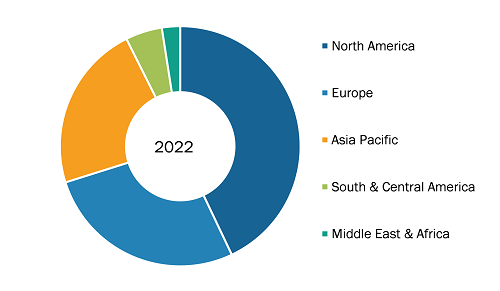Targeted Drug Therapy Segment, by Drug Therapy, to Dominate Breast Cancer Therapeutics Market During 2022–2030
According to our new research study on "Breast Cancer Therapeutics Market Size and Forecast (2020–2030), Global and Regional Share, Trends, and Growth Opportunity Analysis," the breast cancer therapeutics market size is expected to grow from US$ 31,073.52 million in 2022 and to reach a value of US$ 63,967.05 million by 2030; it is anticipated to record a CAGR of 9.4% from 2022 to 2030. Key factors driving the market growth are growing burden of breast cancer and launch of several diagnostics and screening programs. However, high cost of diagnosis and treatments hinders the breast cancer therapeutics market growth.
Governments of various countries across the globe recognize the importance of addressing breast cancer and are implementing policies to improve access to effective treatments. Many governments and private organizations have increased funding for research and development in breast cancer therapeutics, resulting in the development of innovative drugs and therapies. For instance, Susan G. Komen, the leading breast cancer charity in the world, recently announced the awarding of 49 new grants to scientists at 28 prestigious US universities. The US$ 19.3 million in new grants continue Komen's dedication to assisting the next generation of diverse leaders in breast cancer research while supporting two areas of focus—advancing precision medicine and eradicating disparities in breast cancer outcomes. This increased investment in research has allowed pharmaceutical companies to explore new treatment options and develop highly targeted and effective therapies for breast cancer patients.
Breast Cancer Therapeutics Market , by Geography, 2022 (%)
Breast Cancer Therapeutics Market Size and Forecasts (2020 - 2030), Global and Regional Share, Trends, and Growth Opportunity Analysis Report Coverage: By Drug Therapy [Targeted Drug Therapy (Abemaciclib, Ado-Trastuzumab Emtansine, Palbociclib, Trastuzumab, and Other Target Drug Therapies), Hormonal Drug Therapy (Selective Estrogen Receptor Modulators, Aromatase Inhibitors, and Selective Estrogen Receptor Downregulators), Chemotherapy, and Immunotherapy/Biological Therapy], Breast Cancer Type (Hormone Receptor, HER2+, and Triple-Negative Breast Cancer), Distribution Channel (Hospital Pharmacies, Drug Stores and Retail Pharmacies, and Online Pharmacies), and Geography (North America, Europe, Asia Pacific, Middle East & Africa, and South & Central America)
Breast Cancer Therapeutics Market Size and CAGR by 2030
Download Free Sample
Source: The Insight Partners Analysis
Several government bodies across the world are also taking steps to improve access to these treatments by implementing reimbursement policies and healthcare initiatives that cover the cost of breast cancer therapeutics for patients. This means that more patients can afford these treatments and have access to the latest advancements in breast cancer therapeutics. The increased government support has also created a favorable market environment for healthcare providers. With more funding and resources available, healthcare providers are able to offer their patients a wider range of treatment options. This improves patient outcomes and allows healthcare providers to stay competitive in the market. Overall, the increased support from governments and private organizations for breast cancer therapeutics has driven innovation, leading to new and improved treatments. It has also improved access to these treatments, benefiting more patients. This presents a significant opportunity for the breast cancer therapeutics market growth as pharmaceutical companies and healthcare providers continue to invest in research and development activities and expand their offerings to meet the growing demand.
Eli Lilly and Co, Novartis AG, AstraZeneca Plc, Pfizer Inc, Gilead Sciences Inc, Merck & Co Inc, Genentech Inc., Teva Pharmaceutical Industries Ltd, and Amgen Inc. are among the key companies operating in the breast cancer therapeutics market. The companies have been implementing various strategies that contribute to their growth and lead to various changes in the market. The companies have utilized both organic strategies (such as launches, expansion, and product approvals) and inorganic strategies (such as product launches, partnerships, and collaborations).
For instance, in June 2023, Gilead Sciences, Inc. adopted a positive opinion for Trodelvy (sacituzumab govitecan) from Committee for Medicinal Products for Human Use (CHMP) of the European Medicines Agency (EMA) as monotherapy to treat patients with unresectable or metastatic hormone receptor (HR)-positive and HER2-negative breast cancer patients who have received endocrine-based therapy and at least two additional systemic therapies in the advanced setting.
The report segments the breast cancer therapeutics market as follows:
The breast cancer therapeutics market, by drug therapy, is segmented into targeted drug therapy, hormonal drug therapy, chemotherapy, and immunotherapy/ biological therapy. The breast cancer therapeutics market, by breast cancer type, is segmented into hormone receptor, HER2+, and triple-negative breast cancer. The breast cancer therapeutics market, by distribution channel, is segmented into hospital pharmacies, drug stores and retail pharmacies, and online pharmacies. Based on geography, the breast cancer therapeutics market is segmented into North America (the US, Canada, and Mexico), Europe (France, Germany, the UK, Italy, Spain, and the Rest of Europe), Asia Pacific (China, Japan, India, Australia, South Korea, and the Rest of Asia Pacific), Middle East & Africa (Saudi Arabia, South Africa, the UAE, and the Rest of Middle East & Africa), and South & Central America (Brazil, Argentina, and the Rest of South & Central America).
Contact Us
Phone: +1-646-491-9876
Email Id: sales@theinsightpartners.com